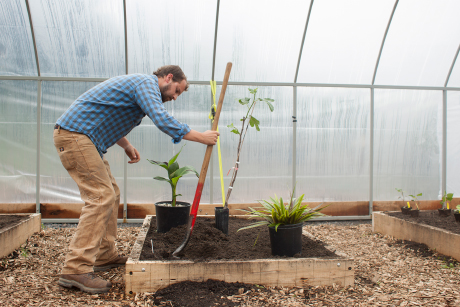High tunnels at Plantations to simulate climate change
By Stacey Shackford

Okra, peanuts, cotton and bananas are not exactly staple crops on Ithaca farms and home gardens. But as the world gets warmer, will there be a place for tropical varieties in New York state? And what will happen to current crops such as lettuce, radish and spinach?
Cornell researchers aim to find out by simulating potential climate change conditions under plastic.
A high tunnel – an unheated greenhouse covered by a single layer of clear polyethylene – is being erected at Cornell Plantations to house a climate change demonstration garden.
The high-temperature, controlled precipitation environment will be used by student and faculty researchers in the Departments of Horticulture and Landscape Architecture to research the effects of changing growing conditions on growth and survival of select plants, and potential adaptive solutions.
It will also be an educational tool for the 50,000 people who visit Plantations’ botanical gardens, arboretum and natural areas each year, said Sonja Skelly, Cornell Plantations director of education.
“It is an ideal location to mount such a demonstration, and we are excited to provide an additional opportunity for students and visitors to explore environmental issues through the lens of the garden,” Skelly said.
The 480-square-foot structure will be located in Plantations’ Pounder Garden near the Sustainable Backyard, which features a series of installations focused on sustainability issues. The high tunnel will house six beds of plants, including unusual species of tropical origin, temperate species, tender perennials, landscape plants, plants found in New York and long season peppers. Additional beds will be located outside the tunnel, to allow visitors to compare how the varieties cope in different growing conditions.
High school students in the Plantations Environmental Education Program for Sustainability will help plant the garden and follow its progress. The garden has also been integrated into the curriculum of several undergraduate courses.
“While the public may perceive the warmer summers and occasional droughts, the practical effect of these and other environmental changes on plants, ecosystems and long-term agricultural productivity is difficult to grasp,” said Chris Wien, professor of horticulture, a principal investigator on the project along with Skelly and Josh Cerra, assistant professor of landscape architecture.
Plant choices have significant effects on the sustainability and organic management potential of gardens, farms and managed landscapes, Wien said.
“This garden will illustrate the effect of elevated temperature and changing precipitation on the growth of plants and plant communities. It will show that these changes can have both harmful and beneficial effects on plant performance depending on the species,” he added.
High tunnels have long been used to elevate temperatures to foster plant growth and to extend the growing season for crops. Their use as tools for outreach and climate change research is novel, however, and Wien hopes the project will be a catalyst for similar efforts elsewhere.
“Simulating climate change effects using high tunnels could lead to better understanding of the potential impacts on regional plant communities, horticultural products and managed landscapes,” Wien said. “Future research programs could guide more sustainable future planting choices and practices in the agricultural, restoration, horticultural and landscape-design industries.”
The project was funded by the Towards Sustainability Foundation, a Boston-based philanthropic organization that fosters research and demonstrations of organic and sustainability issues in agriculture.
Stacey Shackford is a staff writer at the College of Agriculture and Life Sciences.
Media Contact
Get Cornell news delivered right to your inbox.
Subscribe